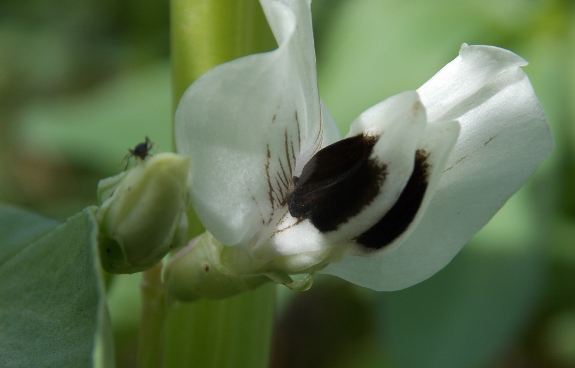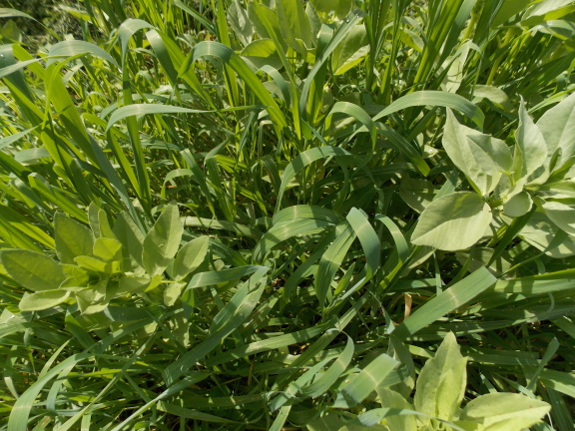
Mixing fava beans with other cover crops

Our fava beans are starting to bloom! The flowers are definitely photogenic, but will the resulting beans be tasty?

Of course, since I'm primarily interested in the fava beans as a cover crop,
the real question is --- how much biomass will they produce and do they
mix well with others? The jury's still out on the first question,
but the mixing results are starting to come in.
The photo above shows some fava beans I interplanted with oats --- even
though the beans are a bit hard to see to the human eye, the plants are
doing nearly as well as those grown alone and mulched in another
bed. On the other hand, fava beans at the feet of sunflowers are
much more spindly, perhaps because they're in soil that I haven't babied into top productivity yet.
Or perhaps the sunflowers simply shade the fava beans too much, or the
sunflowers' established roots are hard to compete with? This
second hypothesis seems more likely since fava beans in poor soil
interplanted with oilseed radishes look nearly as good as those
interplanted with oats.
Have you tried mixing fava beans with other cover crops? I'm
always curious to hear about cover crop mixtures that do and don't make
the cut.
Want more in-depth information? Browse through our books.
Or explore more posts by date or by subject.
About us: Anna Hess and Mark Hamilton spent over a decade living self-sufficiently in the mountains of Virginia before moving north to start over from scratch in the foothills of Ohio. They've experimented with permaculture, no-till gardening, trailersteading, home-based microbusinesses and much more, writing about their adventures in both blogs and books.
Want to be notified when new comments are posted on this page? Click on the RSS button after you add a comment to subscribe to the comment feed, or simply check the box beside "email replies to me" while writing your comment.

What I remember reading about alleopathy with sunflowers was that the seed hulls carried whatever chemical is the problem. However, I grew a small patch of sunflowers in one of my garden beds, and late in the summer, after a few had died and birds had stripped seeds out of maybe 50% of the remaining heads, I was able to grow a romaine lettuce, arugula, dill, radish, and nasturtium under the flowers (the nasturtium was planted much earlier in the summer, but germinated closer to when the lettuce did. For some reason, I can't get the seeds to germinate when I want them to... possibly b/c they are very cheap seeds.)
I took a workshop recently with Darren Doherty in which we talked about a wiiiiide variety of permaculture topics, one of which was cover crops. He mentioned that when you use legumes as a cover crop, you need to cut them down before they produce seeds or pods. It's at that point that the highest amount of nitrogen is in the soil. If you let them go to seed (or, plan to eat from your cover crop), then the plants will take nitrogen that was originally fixed in the ground, and send it up to develop the seeds. Anna, have you read anything about this? It makes sense to me, but I don't have any experience to back it up.
Kathleen --- I'll have to dig into the allelopathy issue --- thanks for the heads up!
Stephen --- Cutting right at flowering is definitely the best way to get maximum nitrogen into your soil from leguminous cover crops. We've never really grown our cover crops for nitrogen in the past, preferring to focus on organic-matter addition, but now that a lot of our soil is good and dark, it would be good to start experimenting with nitrogen-fixers in order to lower our dependence on manure. On the other hand, I always figure if humans or livestock will eat part of a crop, I should feed it to them first --- the nitrogen will still cycle back around to the garden once I topdress with manure. That's why I only felt a few qualms while letting our new goat nibble on oat leaves that were supposed to turn into winter mulch this afternoon.